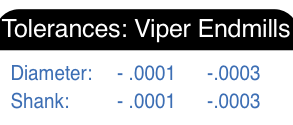Many times when machinists look at cutting tool speeds and feeds, they are often misled into believing that they should be concerned with horsepower. The real driving force is not horsepower, it’s TORQUE. In order to maximize your speeds and feeds you should have a good understanding of how your CNC machine develops and holds torque.
Torque is the measure of how much immediate rotational force a spindle drive motor can generate. The image at the right shows Relationship between force F, torque τ,linear momentum p, and angular momentumL in a system which has rotation constrained in one plane only (forces and moments due to gravity and friction are not considered).
End Mills in the Old School
Traditionally, a 1” diameter end mill would require high torque and low speed , while a 1/4” diameter end mill would require high speed and low torque. Generally speaking, different end mill diameters & geometries have different requirements for both Horsepower and Torque.
Destiny End Mills
However, as a general rule most of our end mills are designed to be run at high RPM regardless of diameter. We prefer high speed AND high torque. Our tool geometry is optimized for high speed machining.
A while back we talked about our tooling geometry and how our end mills can have up to 3 rake face in the cutting edge of the tool. As the tool enters the cut and takes the first 3-5 revolutions (and remember you can be running up to 18,000 Revolutions Per Minute) there is a tremendous amount of cutting force placed upon the tool and you can notice your HP meter jump as the tool enters the cut multiple times. This entry is when the torque curve on your CNC machine is the most important. Older CNC machines where designed to quickly reach peak torque between 1200 - 3000 RPM and then drop off. Newer, high speed machining centers hold constant torque.
Think of it like this. When a hydrofoil starts off from the dock it's not up to speed so it requires both HP and torque until the hull of the boat lifts off the surface. At that point a couple important changes happen in power consumption because the ship has "lifted" from the surface: The coefficient of friction has dropped dramatically. Similarly, once our tools are "in the cut" the chip formation "lifts" from contact with the gullet of the tool (the 'core diameter"). Horsepower is not quite as important as maintaining torque in the cut especially as you interpolate around a corner in a full slotting application.
A while back we talked about our tooling geometry and how our end mills can have up to 3 rake face in the cutting edge of the tool. As the tool enters the cut and takes the first 3-5 revolutions (and remember you can be running up to 18,000 Revolutions Per Minute) there is a tremendous amount of cutting force placed upon the tool and you can notice your HP meter jump as the tool enters the cut multiple times. This entry is when the torque curve on your CNC machine is the most important. Older CNC machines where designed to quickly reach peak torque between 1200 - 3000 RPM and then drop off. Newer, high speed machining centers hold constant torque.
Think of it like this. When a hydrofoil starts off from the dock it's not up to speed so it requires both HP and torque until the hull of the boat lifts off the surface. At that point a couple important changes happen in power consumption because the ship has "lifted" from the surface: The coefficient of friction has dropped dramatically. Similarly, once our tools are "in the cut" the chip formation "lifts" from contact with the gullet of the tool (the 'core diameter"). Horsepower is not quite as important as maintaining torque in the cut especially as you interpolate around a corner in a full slotting application.
We like Constant Torque
 |
| Spindle Torque Efficiency |








